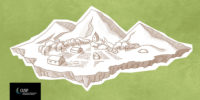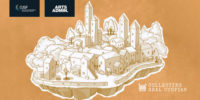The urgency of reciprocity with the vegetal, fungal, and animal
This is the fourth blog in the ‘Collecting Real Utopias’ series, which aims to collect, connect, and celebrate arts-based real utopian projects from around the world. It is rooted in CUSP research by Dr Malaika Cunningham, which explores the overlaps between democracy, environmental justice, and participatory arts. To learn more about what is meant by ‘real utopias’ and the overall ambitions for this series, please have a look at her first blog. This article also appeared on the Arts Admin website.
BLOG by MALAIKA CUNNINGHAM
In my last blog I focused on land justice. Specifically exploring who has access to land and its design, with particular reference to the dreaming field lab. This month’s blog continues the theme of land justice, but with a focus on socially and environmentally just food systems.
A number of years ago I read the Oryx & Crake trilogy by Margaret Atwood. In this sci-fi trilogy, Atwood builds a dystopian (but increasingly realistic) world in which climate change and a horrific global pandemic has decimated organised society. The survivors of the pandemic roam through abandoned cities, hunted by crazed genetically modified pigs, as well as desperate, hungry humans. I think about these books a lot—the world Atwood creates frames my own frequent, anxiety-ridden musings on ‘what I would do to feed myself at the end of world’. Perhaps it is because as I read Oryx & Crake, I was also studying and beginning to understand the likely and terrifying impacts of climate change on global water and food systems.
Despite the anxiety which often accompanies my reflections, it is actually the utopian moments contained within this dystopian world which have stayed with me over the years. The egalitarian, caring communities which pop-up at Atwood’s ‘end of the world’. A key focus of this fictional community within the books is food production and medicine. The survival of this community depends on a reciprocal relationship with land, plants, insects, and animals. Knowledge of and care for nature become essential to survival.
Within this fiction, the interdependence between human and non-human life is simplified into its most basic form. This relationship is also with us in reality, but in a way that is more complex, disassociated, and on a much larger scale. I think it is at its most tangible when we think about food inequalities and food insecurity. In her book, Farming While Black, Leah Penniman refers to these inequalities in the USA as ‘food apartheid’: ‘a system of segregation that relegates certain groups to food opulence and prevents others from accessing life-giving nourishment’ (2018, p.4). Predominately black communities across the USA live in areas where it is difficult or even impossible to access healthy, fresh, affordable food. On average, ‘predominately white neighbourhoods have four times as many supermarkets as predominately black neighbourhoods.’
This trend is the same in the UK: ‘it’s estimated that black and ethnic minorities are 1.5 times more at risk of food insecurity as White-British’. Food banks have become commonplace. In 2008, there were just under 26,000 food bank users. This year in 2021, it’s up to 2.5 million. The nature of food banks makes providing fresh food almost impossible. None of the food banks I have worked with have been able to regularly provide fresh food to their users—this is down to a combination of food safety policies and practicalities. This has an impact on broader health issues, wellbeing, even life expectancy. And it will likely get much worse as the impacts of climate change push up food prices and disrupt both local and international food systems.
Our current agricultural systems are not only unequal and discriminatory, they are also unsustainable: polluting, degrading, and extractivist. The social and environmental injustices of this system are interrelated and cyclical—rooted in colonialism and exacerbated by capitalism. Others have written much more of the impact of climate change on food systems (I want to offer a bit of a trigger warning on the link here—it is important, but frightening).
There are also many, many wonderful real utopian projects working at these issues, particularly exploring the intersectionality between social and environmental injustices in this field. Some projects of varying scale which are worth highlighting and celebrating, include: the May Project Gardens in London, Land In Our Names (or LION) across the UK, the Guerrilla Grafters (worldwide), and Movimento dos Trabalhadores Rurais Sem Terra (in English—the Landless Peasants Movement) in Brazil. Each of these projects are challenging the current extractivist and unequally distributed food system – often using some arts-based methodologies—and, in so doing, modelling alternative ways of doing things.
The project I want to look at this month is The Soul Fire Farm, started by Leah Penniman in New York State. Her book, Farming While Black gives a detailed overview of this project, and offers a practical guide to starting racially and environmentally just farm projects. Her work is based on the wisdom of African Diasporic farmers and activists. We stand on the shoulders of giants—Penniman’s work beautifully acknowledges this whilst providing a whole new level of big, broad shoulders to stand upon. I want to focus in on one specific aspect of this work: the central role of ritual and spirituality at the Soul Fire Farm. The ritual practices at the Soul Fire Farm frame a system of reciprocity between the land and human stewards of this land. It is a form of communication, offering “being-ness to the non-human energies of our world” (p.58).
I have just spent a week in Ljubljana with the ACT Summer Lab exploring the relationship between trees and cities. A core theme of this residency was about building systems of reciprocity between plant and human life—in so doing, building forms of communication. This has become a key theme within environmental movements, environmental research, and the subject of numerous contemporary arts projects. Not least the dreaming field lab by Jennifer Farmer and Zoe Palmer mentioned in last month’s blog (link above)! How can we communicate with plants? How can they have a voice within environmental policy-making, which so deeply impacts them?
In my view there are two routes towards communication with plants. The first is scientific—in learning about plants, we learn their needs and their uses. On a very basic level: we offer plants the conditions they need to thrive and take what we need from them. It is useful, practical, and essential to growing food and medicine. Yet, by itself, this scientific communication can be problematic: within capitalism we take much, much more than we need (and, as articulated above, in an incredibly unequally distributed way). The scientific approach to our interactions with nature has long been in service to this extractivist relationship. The second route to some form of communication with the non-human world is spiritual, cultural, and intuitive. This approach recognises the autonomy of the plants we depend upon, recognises their power, and celebrates them. It builds systems of care which frame our relationships with plants based on reciprocity, rather than extractivism. The Soul Fire Farm interweaves both the scientific along with the spiritual to create an environmentally just space: which offers autonomy to the human and non-human users of the farm.
The gap between my own artistic practice / research, and my fascination with growing food is slowing closing. After a four year waiting list I have been very lucky to have been offered an allotment in Sheffield. It is an incredible site—laden with fruit trees and bushes. Spending time there over the past few months, alongside my research for this blog, and my time in Ljubljana, has begun to illuminate some ways in which my work on democracy and participatory theatre may also connect to growing food. I have a lot of learning to do: practical, academic, and spiritual, in terms of the intersections between land justice, democracy, and participatory theatre.
The final stage of our current long-form participatory theatre installation, The People’s Palace of Possibility, will be a food forest—co-owned by the participants. I hope this may one day be an example of a real utopia—bringing joy, democratic autonomy, and food to good number of people, and health and nourishment to a good number of non-human inhabitants—enabling multiple systems of reciprocity.
One function of this blog going forwards will be mapping this learning about the intersections between democracy, artistic practice, and land justice. Over the next two years I will be visiting, speaking with, and reading about this space—as I also begin to plan for my own land-based project. I will map this through the frame of real utopias in this blog. If you know any projects I should be visiting and/or reading about—please do get in touch! malaika@artsadmin.co.uk.



